Period
Barn Restoration |
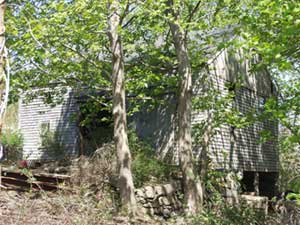 Barn
Barn
|
 Basement Level
Basement Level |
| When
the present owners acquired this early-1800's barn, it was
nearly falling down. The foundation was unstable. Many of the
foundation posts -- cedar tree trunks -- were rotting away.
In the barn itself, many of the joists, rafters, floorboards,
and beams were also decayed. The walls and windows were in
bad condition. |
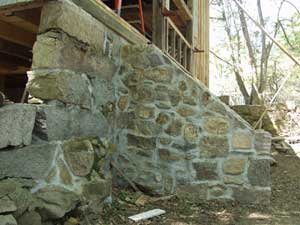 |
The
foundation had to be restored first. The barn was jacked up,
and the original foundation was re-pointed where needed. The
foundation on the back side of the barn had shifted, and was
leaning. New buttresses were added to stabilize and strengthen
the original foundation wall. |
| Once the foundation
was sound, work began on the structure itself. All the deteriorated
support pillars and carrying beams had to be carefully removed
and replaced. Where old support pillars were removed, new footings
were poured to provide a solid base for the new supports. Much
of the "new" wood used in this project was recycled. |
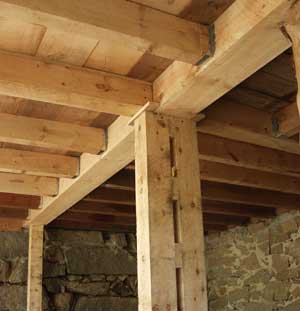 |
 |
Placing the support
beams on the foundation involved much detail work. |
| The old studs were,
of course, fewer than today's building codes require, and much
of the siding had weathered, worn, and deteriorated beyond
saving. New studs and siding were added in sections. |
 |
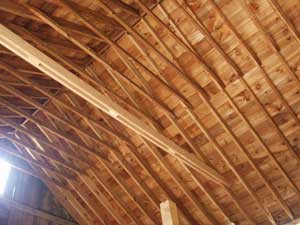 |
The roof structure
was weak. New support beams were added where needed for safety
and stability. |
| The new loft needed
flooring and joists. Small windows below the roof ends provide
natural light. |
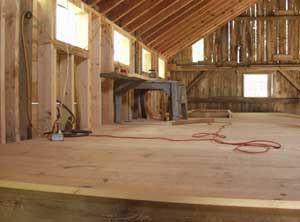 |
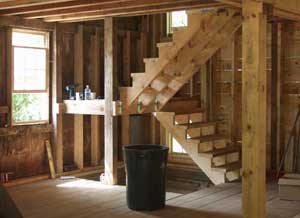 |
Stairs were needed
to get to the loft. Most old barns simply have ladders to the
hayloft, but this barn will now be used primarily by people,
not for hay storage. |
| Where the original
windows could not be used, new windows were hand fabricated
to match the original multi paned windows. Sheathing
used here is recycled rough sawn pine. |
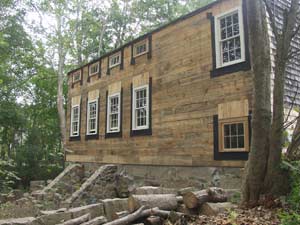 |
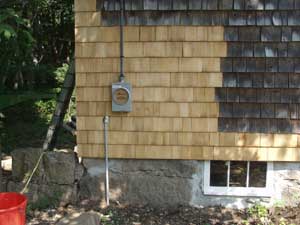 |
Electrical service
was added. the original shingles were adequate in many places;
we're replacing only the truly worn out ones. The owners have
already started landscaping in areas where work has been completed. |
| The loft's recycled
rough sawn railing is now in place. The gaps shown
in the un-renovated exterior wall in this photo, illustrate
the condition the barn was in before work began. |
 |
 |
The L-shaped loft
covers the back and one end of the barn. The area inside the
main barn door is open from floor to roof line. Beams
came from the Cataumet sawmill. Prior to that they were in
a mill building on the North Shore. |
| Two carpenters preparing
to install a window in the loft area. Sheathing
in the loft came from pine that was cut to make room for a
cranberry bog. |
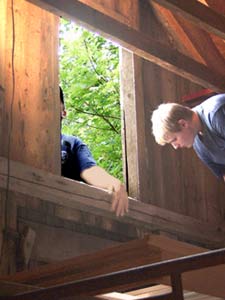 |
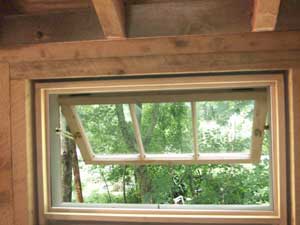 |
One of the windows
installed under the roof ends. |
| The barn was completed
over a period of years. The main floor and the loft, currently
storing things for the winter, can be used for barn dances
and other parties. The loft can also be used for sleep-overs
for the grandchildren. |
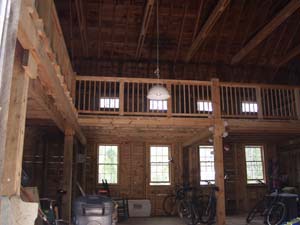 |
This barn goes
with the Historic House restoration
that was done three years previously. When one of
the barn owners, an Architect, was discussing some of our
Barn Renovation methodology with our lead Carpenter, who
is a multi-year craftsman in such restoration techniques,
it became obvious
this individual had less experience and knowledge regarding
the project at hand.
We worked with him and the other two owners; also Architects,
as part of a cohesive team with a shared
goal.
Some days it was dialog, dialog, research, discussions and
solutions. Other days were humor with joyful
results. As you can imagine, we as contractors can provide
unique, special experiences at many levels.
Enjoy what we ALL produced! Return to Project Gallery |
|